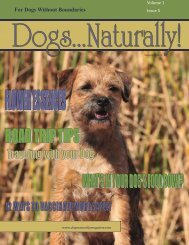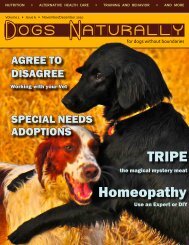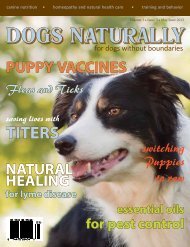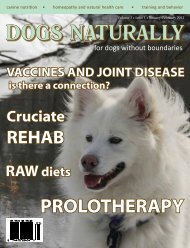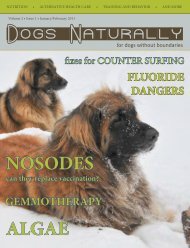July/August 2010 - Dogs Naturally Magazine
July/August 2010 - Dogs Naturally Magazine
July/August 2010 - Dogs Naturally Magazine
You also want an ePaper? Increase the reach of your titles
YUMPU automatically turns print PDFs into web optimized ePapers that Google loves.
y: Jean Donaldson<br />
Dear Jean,<br />
I just got a new nine week-old Rottie puppy. He’s<br />
stunning, smart and generally friendly but<br />
growls and snaps if I go near him while he’s eating.<br />
He also does this to my adult Rotties. I’ve<br />
never seen this in a puppy so young. Is he some<br />
sort of lemon? Is he a dominant dog? Is there<br />
anything I can do? Help!<br />
It is indeed alarming for most people to see frank aggression in<br />
puppies. In the case of resource guarding – food, bone, bed<br />
etc. possessiveness – there is good news and bad news. The<br />
good news is you can start addressing it in a young, hopefully<br />
plastic, spongy puppy with weak jaws. The bad news is that<br />
there is some sentiment out there among trainers that aggression<br />
in puppies is an insidious sign of the problem having Deep<br />
Genetic Roots and therefore fruitless to tackle. I’m going to<br />
explore the whole nature-nurture debate later but for now will<br />
simply say that there doesn’t seem to be any overwhelmingly<br />
tidy correlation between behavior problems that are thought<br />
to have a strong genetic component and their susceptibility (or<br />
lack thereof) to behavior modification.<br />
I recently had a similar case, in my own foster puppy. Buffy, a<br />
stray six week-old Chow, presented with object and food<br />
guarding against people and dogs. I elected to not touch the<br />
dog-dog issues, which is a relatively common approach. Her<br />
socialization and play skills were coming along nicely and she<br />
was developing good acquired bite inhibition. The guarding<br />
against people, however, needed to be actively resolved. The<br />
following is a summary of Buffy’s food guarding exercise regime.<br />
Incidentally, Buffy also presented with socialization deficits<br />
and severe body handling problems, which were also addressed,<br />
as was her object guarding. The key to good hierarchy<br />
design is small enough incremental steps that at no point do<br />
you see the original guarding problem. In the case of a puppy,<br />
such as this, there may actually be more aggressive increment<br />
jumps. I did a few other things in the can’t-hurt-might-help<br />
category. These included impulse control (stay, off and wait)<br />
and extra soft-mouth training.<br />
Baseline<br />
When approached while eating<br />
from her dish, Buffy would freeze<br />
and, if approach continued, growl briefly and then lunge and<br />
snap. If touched while eating, she would growl simultaneous<br />
to whirling and biting. Due to the independent body-handling<br />
problem, this had to be partly resolved prior to combining it<br />
with food bowl exercises. Buffy did not guard an empty dish.<br />
Hierarchy<br />
Step 1 (day 1): Installment feeding of canned food. I sat on the<br />
floor next to Buffy’s dish and spooned in one mouthful. Once<br />
she had swallowed, I spooned the next mouthful into her dish.<br />
By the end of the second meal, she demonstrated a clear<br />
happy anticipatory orientation to my spoon hand after each<br />
swallow.<br />
Step 2 (day 1-2): Overlap. This was essentially the same as Step<br />
1 except that I added the next spoonful to her dish while she<br />
was still consuming, always a much dicier proposition. We did<br />
this for three meals without evidence of guarding seen.<br />
Step 3 (day 2-3): Approach overlap. I was now standing. I<br />
spooned larger installments, withdrew two paces, reapproached<br />
and added the next spoonful while Buffy was still<br />
consuming. So, this combined approach with the overlap exercise.<br />
We stuck with this for three meals, at end of which time a<br />
Conditioned Emotional Response (CER) had become evident –<br />
Buffy wagged and looked up on approach. We then repeated<br />
the exercise for one more day (5 small meals) with larger withdrawal<br />
distances and intervals.<br />
Step 4 (day 4): Trumping. Now I spooned her entire puppysized<br />
ration into her bowl. I withdrew five paces, paused 15<br />
seconds, approached and added a (hidden) marble-sized dollop<br />
of goat cheese. I had pre-auditioned the goat cheese out of<br />
context and ascertained it to be in Buffy’s Top Five All Time<br />
Foods. I withdrew to six paces and waited for Buffy to continue<br />
to consume – this was not immediate (typical of trumping –<br />
dog orients to handler rather than back to dish) – then repeated.<br />
On the third trial I got a clear CER– withdrawal from<br />
bowl on approach, orientation to me and tail wag. Clever little<br />
thing.<br />
Step 5 (day 4-6): Covering High Value Base. To up the ante, I<br />
tried some approaches while she was consuming a top food<br />
(bowl of treats), rather than normal meal ration level food. I<br />
trumped it with higher value stuff (gorgonzola). In two trials, I<br />
<strong>Dogs</strong>...<strong>Naturally</strong>! <strong>July</strong>/<strong>August</strong> <strong>2010</strong>



